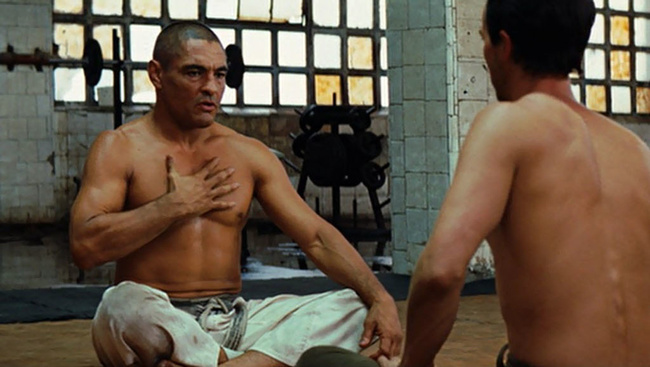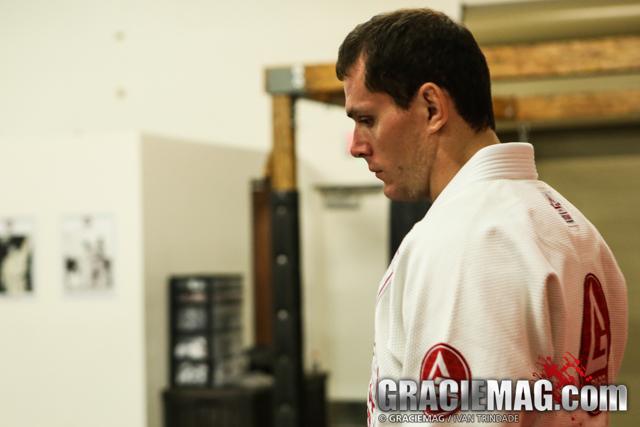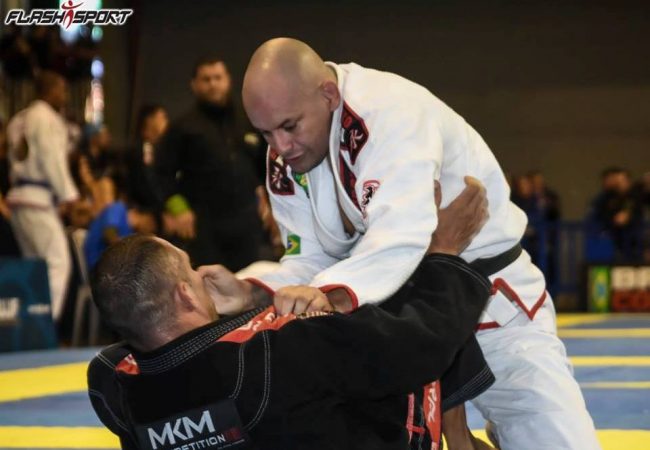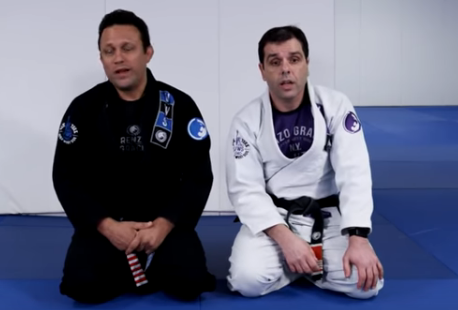
Rickson Gracie’s scene with Edward Norton in The Incredible Hulk. Universal Pictures
[First published in 2008. Part of the Training for Warriors series, by Martin Rooney*]
Fool your instincts — How to stop adrenaline from screwing up your performance
There are two mental zones when it comes to high-level performance: one that is pure performance and one that is pure adrenaline. One is known in science as “flow” and the other as “fight or flight.” Interestingly, each has similar characteristics: a feeling of time slowing down, an experience of having no mind, and actions based on instinct. The dilemma is that one “zone” leads to optimal performance and one can be disastrous. The ability for an athlete to learn to access one zone and resist the other is the next frontier in athletic training. Over the last 5 years I have studied these phenomena of the mind and have learned only one truth: these states rely on both physiology and psychology and the mechanisms for accessing these states are highly varied and individual. I believe the key to developing the mind into a weapon that works for and not against you demands deep understanding, and practice. In issue 114 of GRACIE Magazine I examined the “flow” or “zen” state in performance. This article will attempt to shed light on flow’s evil counterpart, the fight or flight response.
When I saw the Incredible Hulk movie, I had an epiphany about this topic, compliments of Rickson Gracie. If you have not seen the movie, Rickson plays a master that uses breathing techniques to help Bruce Banner control his emotions and heart rate so Banner won’t have an adrenaline response that turns him into the thoughtless, mindless, raging Hulk. The epiphany was not that we can lower our heart rate with breathing or that repeated stress presentation can help us weather stresses when they come, but that it is our own thoughts that must be controlled if we are ever to reach the pinnacle of our own performance.
When I looked at how the Hulk was presented as this thoughtless monster of instinct, I was reminded of a performance I had at a past competition. At this no-gi event, I was warming up Rafael “Gordinho” Correa for a superfight, and ended up late for my own match. My name was called over the loudspeaker and I ran over to the mat to avoid disqualification. With no mental or physical warm-up, I was thrown right into the match. Immediately after the ref started us, I was taken down and found myself shocked and scrambling from half guard to stay alive. My mind went blank. I reverted back to technique mindlessly and got a half guard sweep and controlled from the top to win the match. After this win, however, I was more tired than I have ever been in my life, almost nauseous to the point of vomiting, unable to coherently think or communicate and felt like quitting because I had another match in a matter of minutes. I was in a state of fatigue, confusion and the fear caused by my unfamiliarity with this experience. What I didn’t know was that I just had my first “adrenaline dump” and that understanding this phenomenon would be a key to unlocking the mystery that plagues every athlete from time to time. Having experienced this event first hand and having seen this occur repeatedly in competition, I believe that controlling this physiological process is a distinguishing ability between the master and amateur during competition.
So what is the adrenaline dump?
Depending on the scientific literature, the adrenaline dump can also be found referred to as Tachypsychia or the Fight or Flight Response. This is a protective mechanism that has evolved from prehistoric times to enhance a human’s chance of survival by preparing your body for a life threatening event. The good news is that this response can result in increased speed, strength and decreased perception of pain. The problem is that this ancient mechanism also has many other effects that can be disruptive to modern-day high-level performance.
The Adrenaline Dump can be described scientifically as hereunder:
Once a potentially dangerous stimulus is perceived, sections of a person’s brain called the hypothalamus and brain stem are activated. That activation leads to the person becoming alert and attentive to the environment. This is analogous to the prehistoric heightened period in which a gazelle assesses the situation after seeing a lion approach.
The more threatening the stimulus is perceived, the more the sympathetic nervous system is activated. This activation causes the adrenal glands to release the hormone epinephrine (adrenaline) into the blood stream. Once this occurs, there are a number of physiological cascades that happen almost immediately. As you will see, they may be great for the gazelle that is now forced to escape the lion, but the list below can be destructive for high-level performance that requires thinking, fine technique and control for 15 minutes or multiple matches throughout a day.
Physiological responses:
⦁ Increased heart rate and blood pressure.
⦁ Dilation of the bronchial passages
⦁ Dilated pupils allowing more light to enter
⦁ Dilation of blood vessels for muscles
⦁ Raising of Blood Sugar level
⦁ Diversion of blood away from areas of the brain and the internal organs
⦁ Inhibition of stomach and intestinal action
⦁ Tunnel Vision (loss of peripheral vision)
⦁ Auditory exclusion (decreased hearing)
Motor and psychological responses:
⦁ Increased pain tolerance
⦁ Short term memory loss
⦁ Decreased fine motor skills
⦁ Decreased communication skills
⦁ Decreased coordination
⦁ Difficulty thinking
⦁ Shaky, weak or nauseous feeling
⦁ Feeling that time has slowed down
⦁ Feelings of fear, panic or helplessness
When I examined the process of and responses from the Adrenaline Dump, I realized two important things. First, the event is triggered by our own perception. This tells me that it is our own mind that is in control of the fact the event is going to occur or not. So, our perception does create our own reality and, therefore, the event is something we can learn to control. Second, once this biochemical event is triggered, there is little we can do to stop it. This means that we want to prevent the event from happening in the first place. The facts that we don’t know exactly what may trigger the adrenaline dump and that there is difficulty in replicating “high stress” situations in training makes controlling this event a challenge. They do not, however, stop us from training to keep our “inner Hulk” at bay.
Through my study of this response, I found a number of potential concepts to help prevent this event from occurring. Although none is foolproof, you must still commit to working on the mind as much as you do on the body. Below is a list of three possible suggestions to keep your most important weapon in check.
1. Mental imagery, visualization and self talk
Visualization is a very powerful tool when it comes to blunting the fight or flight response. By using imagery and self talk to replicate possible scenarios before they occur, your body and mind have a better opportunity for handling them in reality. Involving all of the senses (including the sights, smells, and feel of the arena, etc) is important here. Even though mental scenarios might not be real, science has shown that imagery is very powerful for familiarity with a potential event. This way, an athlete can be more relaxed because the mind believes they have already “been there” by rehearsing possible events before they actually happen.
Action Step: Create your own “highlight” reel. Every night before you go to sleep, vividly imagine yourself competing and most importantly, succeeding.
2. Train under stress with repetition
All too often, we don’t like to put ourselves in bad positions during training. But then when they happen during a fight, we are completely unprepared on how to handle them. A great way to be ready for worst-case scenarios in a match is to have placed yourself in those situations many times in training! Make sure you repeat these situations many times so that you can have confidence in tight situations. This confidence will allow you to stay relaxed even when the going gets tough.
Action Step: During a training session, place yourself in your least favorite positions and do rounds with fresh opponents while attempting to work to a better position.
3. Breathing/ meditation techniques
Simply put, you must learn to make breathing a conditioned response. What I mean is that whether it is putting on the gi, or beginning a warm-up, controlled breathing must be connected with these events. For centuries martial arts have used yoga and meditation to keep arousal down with proper breathing, yet I rarely see athletes experimenting with this style of training today.
Action Step: Using deep, stomach breathing, breathe in through your nose for a count of four, hold the breath for a count of four, exhale through your mouth for a count of four, and then complete the cycle by again holding the breath for a count of four. Practice this technique for 10 minutes multiple times per day and use this as a form of stress reduction.
Your ability to control yourself both physically and mentally under high stress will be the skill that eventually separates you from the competition. The less you are willing to experiment with and practice the suggested techniques above, the more chance you have left open for self sabotage. Science now shows that we are able to use these techniques to affect what we once thought was beyond our control. The Mind of the Warrior is his strongest weapon. Only by learning to control this weapon can you ever unleash it on your competition. Now get to work!
* Martin Rooney is the founder of the Training for Warriors system and has trained champion fighters for the UFC, Pride, ADCC and Olympics. His TFW fitness program is used in over 175 facilities in 25 countries around the world. Information about TFW certifications at trainingforwarriors.com.




